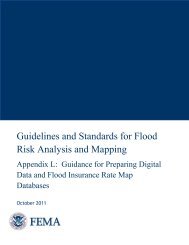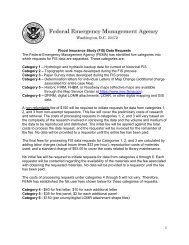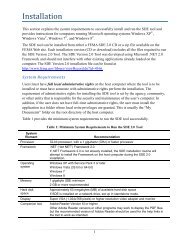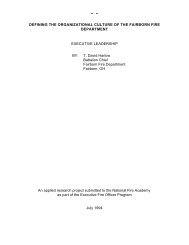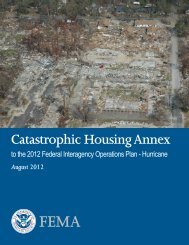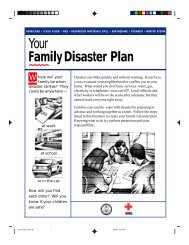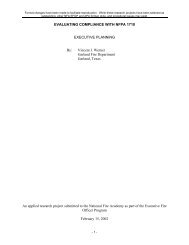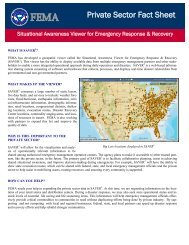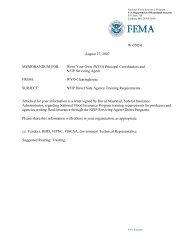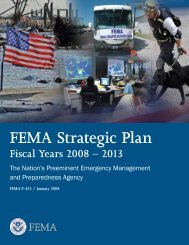Joint Field Office Activation and Operations - Federal Emergency ...
Joint Field Office Activation and Operations - Federal Emergency ...
Joint Field Office Activation and Operations - Federal Emergency ...
Create successful ePaper yourself
Turn your PDF publications into a flip-book with our unique Google optimized e-Paper software.
Interagency Integrated SOPUNCLASSIFIED• Personnel assigned to the JFO will, upon check-in, be assigned account names <strong>and</strong>passwords <strong>and</strong> provided with user-friendly instruction cards describing how to use thesystem.2.2 Information Flow• ICS information management principles will be followed to the greatest extent possible.A basic ICS tenet is that information flows freely, but tasks <strong>and</strong> directions followformal chains of comm<strong>and</strong>. The collaboration <strong>and</strong> posting functions of JFOnetfacilitate adherence to this concept.• When established within the JFO structure, the situation unit or documentation unit, atthe Planning Section Chief’s discretion, is responsible for receiving, consolidating, <strong>and</strong>preparing situation reports (SITREPs). (See Tabs 2 <strong>and</strong> 3 to Annex E for a sample.)• All entities within the JFO, for SITREP inputs, will place their respective inputs ontothe JFOnet for construction of the distributed SITREP.• All JFO entities have a responsibility for posting spot reports (SPOTREPs) on JFOnetas information is received from their areas of responsibility as defined by ICS. (SeeAnnex E for a sample.)• The report cycle of issuance of SITREPs will be determined by the JFO CoordinationGroup, generally following the st<strong>and</strong>ard ICS practice of one SITREP being issued peroperating period.2.2.1 Information IntakeInformation flows into the JFO at many points. This information will generally be routedas follows:• General unclassified information. The JFO Situation Unit is the primary intake<strong>and</strong> assessment point for general unclassified information. Information may berouted in hard copy or by posting to the “Situation Unit Incoming” folder in JFOnet.In the case of a JFO established for a NSSE, the Security <strong>Operations</strong> Branch(MACC) will perform this function unless an Incident of National Significance, orother incident requiring a coordinated <strong>Federal</strong> response, occurs during the NSSE.Following assessment, the JFO Situation Unit or MACC (depending on thecircumstance) posts the information to the information management system <strong>and</strong> willroute the information to internal <strong>and</strong> external customers (including the JOCIntelligence Unit, Intelligence <strong>Operations</strong> Center or JFO Intelligence Section, <strong>and</strong>JFO Information <strong>and</strong> Intelligence Unit).• Unclassified event-related security information. The MACC is the primaryintake <strong>and</strong> assessment point for event-related security information. Where theMACC has not been established, the JFO Situation Unit becomes the primary pointof entry for security or event-related unclassified information.• Law enforcement restricted information. The JOC Intelligence Unit is theprimary intake <strong>and</strong> assessment point for Law Enforcement Restricted Information.Information may be routed to the JOC Intelligence Unit in hard copy, by phone, orother method identified by the FBI. Where the JOC has not been established, theFBI <strong>Field</strong> <strong>Office</strong> becomes the primary intake <strong>and</strong> assessment point for LawEnforcement Restricted information. Information may be routed to the JFO72Version 8.3Interim Approval April 28, 2006



